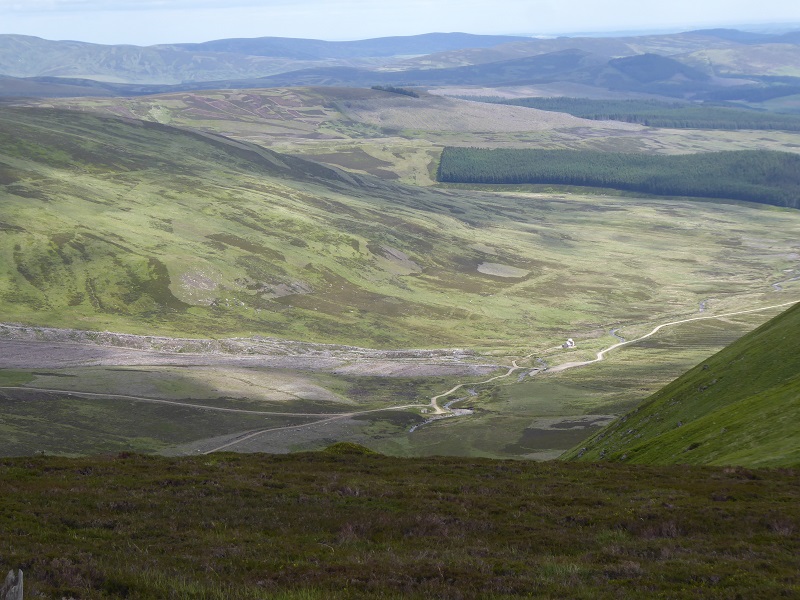
After its initial consultation at the end of last year on its plans for the Angus Glens, including Glen Prosen (see here) and Glen Doll, Forest and Land Scotland (FLS) have produced a “concept proposal” prior to producing a Land Management Plan. They are consulting on until 30th June (see here for documents and video). This post considers FLS’ concept proposals for Glen Prosen, which includes the land they bought for £17,555,000 in 2022 (see here and here) and the land they already owned in the glen, but not its other landholdings in the Angus Glens.
Where are the facts?
Like the initial “scoping” consultation, the concept proposal consultation for Glen Prosen is bereft of background information. There is nothing about the history of land-use in the glen, whether farming, intensive grouse moor management, deer stalking or commercial forestry. The key features map has not been changed since the initial consultation, shows plantations that are no longer there (e.g around the Kilbo bothy) and omits the hydro scheme (but not the associated track). It does, however, show the windblow damage caused by Storm Arwen to FLS’ own plantations in the glen which postdates both.
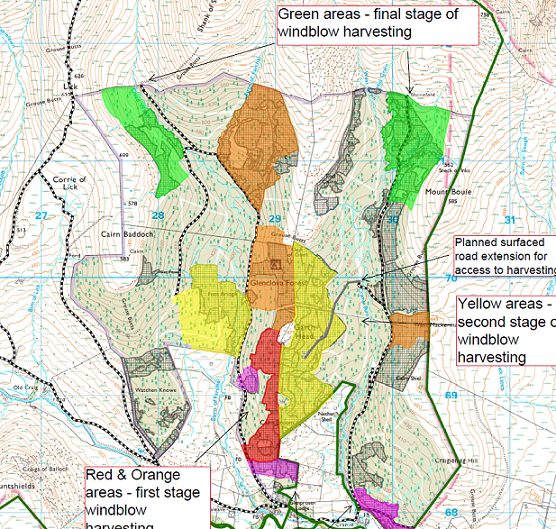
Map 7, depicts three stages of windblow “harvesting” following Storm Arwen, none of which are dated. Two and a half years after the storm most of the timber is likely to be valueless. Despite this commercial disaster and despite windblow harvesting being significantly more expensive than normal industrial harvesting, there is no analysis of any lessons to be learned from impacts of the storm. That is despite the Land Management Objectives document (see below) talking about the need to “plan for resilience”,
With the ever-increasing damage also being done to forest plantations by diseases and pests, the need to re-think the current prevailing model of industrial forestry is obvious and forestry practice in our National Parks would be a good place to start. FLS’ concept map, however, promises more of the same – albeit over a smaller area – with the following proposal: “restructure plantation, focus productivity in core area and integrate outer coupes into surrounding landscape”.
FLS’ Map 2, depicting “Key Features” ,shows the formally designated land in Glen Prosen, the Caenlochan Site of Special Scientific Interest, which extends to the summits of Mayar and Driesh, and the Special Area of Conservation along the River Prosen and its tributaries, but strangely does not show the Wild Land Area (WLA) (see here). Nowhere in FLS consultation documents is there analysis of the condition of ANY of these areas let alone the options for improving them.
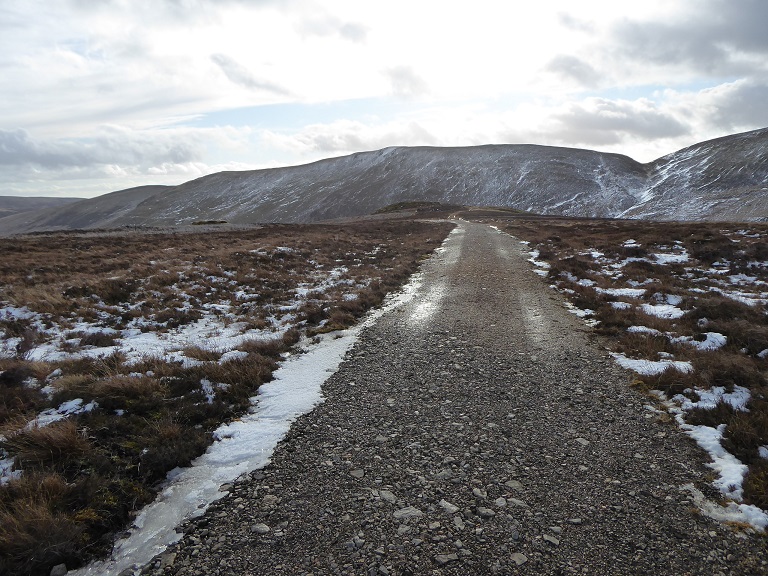
While there is a reference in the documents to the FLS having conducted surveys on its new property since acquiring it 20 months ago, these have not been published with the consultation. It is as a consequence impossible to understand whether or how they have informed the development of the concept proposals.
In short, FLS’ concept proposals for Glen Prosen, as presented in this consultation, appear to be founded on thin air rather than science.
What is FLS’ vision for Glen Prosen?
While it is nowhere clearly stated, FLS’ primary intention for the land in Glen Prosen appears to be “habitat restoration” with a bit of commercial forestry thrown in. What is meant by this term or how the concept proposals relate to the habitats which currently exist in the glen is not explained.
The Angus Glens “land management objectives” document is a veritable sweetie box of restoration imperatives (“restore priority open habitats”, “restore peatland”, “river restoration”, “expand montane scrub”). Sadly, it fails to explain what these objectives mean or how they relate to existing habitats in the glen.
In reality, the primary focus of FLS is on woodland creation and peatbog restoration, both of which of course are activities driven by Scottish Government targets.
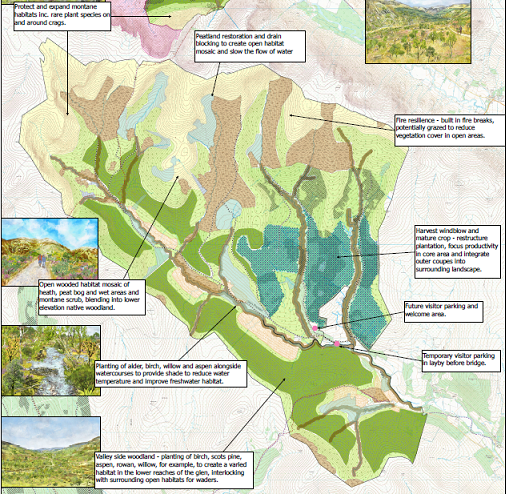
Without any background information or analysis, there is no way for anyone to judge whether any of FLS’ concept proposals, as shown on the map, are appropriate.
The concept proposals give no consideration to the conflicts between peatland conservation and woodland creation and the damage which is being done all over Scotland by planting trees on peaty soils. While map 3 shows areas for peatbog restoration – what needs to be “restored” is again not clearly stated but apparently includes blocking drains – it appears FLS is still proposing to plant trees on peat less than 50cms deep. These are precisely the areas with the most potential to store carbon in the medium term since old bogs start to degrade naturally. In the absence of FLS publishing any surveys of peat depth in Glen Prosen outside the “restoration” areas, the public should assume that a significant proportion of FLS’ woodland creation proposals will result in increased carbon emissions into the atmosphere.
Also lacking from the concept proposals is any explanation of how many trees FLS intends to plant, the overall species mix and by what method. Mounding and the use of plastic tree shelters, still the favoured methods of the forest industry, are both responsible for significant emissions of carbon into the atmosphere along with a range of other destructive impacts (on water drainage, pollution etc).
Another example of the flawed nature of the concept proposals is that to “Protect and expand montane habitats inc. rare plant species on and around crags”, such as South Craig at the head of Glen Prosen above the Mayar burn. Whether any rare plant species can be currently found at South Craig is not explained, nor whether FLS is proposing to re/introduce certain species if they are “absent”.
What seems clear, however, is that whatever FLS is proposing its not about re-wilding but is all about humans deciding what happens where, mainly centred on planting trees. Tellingly, on the concept proposals map there is no mention of moorland, which degraded as it is by overgrazing and muirburn, currently dominates the glen. Despite moorland in other areas being protected and valued for the species it supports (albeit often for the wrong reasons in my view), it appears that in Glen Prosen there will be no place for it.
Instead, FLS is proposing to replace moorland habitats with “Valley Side woodland”, a term which is not defined by FLS and which you won’t find in the British National Vegetation Classification of woodland communities. In doing so FLS makes no attempt to evaluate the gains and losses that might result from this proposed change (for a discussion on this see my critique of the application of the Biodiversity Intactness Index to Far Ralia – see here).
Herbivore mismanagement – deer and fencing
The “Herbivore Management Outline” document starts promisingly, reflecting feedback from the initial consultation which identified this as a key issue:
“We are planning to undertake large scale native woodland creation and peatland restoration across much of the 3,500 hectares at FLS Glen Prosen. The impact of herbivores needs to be reduced substantially for this to happen. The most recent evaluation of deer culls suggests that the deer density is approximately 12-13/km2 across the open range, whereas for natural regeneration of trees to occur this needs to be 0-2/km2.”.
0-2 deer per square is absolutely right, as I have argued in my posts on deer density in the Cairngorms (see here), and a welcome statement. Significantly, however, there is no mention of NatureScot’s new Section 7 agreement to reduce deer density in the Caenlochan SSSI to 10 per square km by 2026 (see here). NatureScot’s agreement creates major challenges for FLS in Glen Prosen:
“This transitory population is highly mobile, and whilst there is no longer a resident group of deer in Glen Prosen or Glen Doll, deer moving in and out of the glens could easily cause damage and inhibit the establishment of new woodland. A large population of rabbits are present in the lower reaches of the glens too, which could also have a significant impact on newly planted trees, as could other small mammals such as mountain hares and voles.”
To digress for a moment and consider the second sentence first, assuming FLS has stopped trapping weasels and stoats on the Glenprosen estate (see here) and is not persecuting foxes, all they would have to do is stop planting thousands of trees at once, and these predators would keep the population of hares, rabbits and voles under control.
“At a Scottish Government and FLS policy level deer culling is the preferred solution and fencing to a degree a measure of last resort.”
While what FLS has done over the last 20 months to implement the preferred solution is not stated (I have submitted an FOI request asking for details of deer culled to date, habitat surveys etc) and the concept proposals do not say how it might control deer in future, by far the most important omission from the consultation is any discussion about how to deal with the problem of hundreds of deer crossing into Glen Prosen from neighbouring sporting estates. Instead of tackling this issue head on, FLS cops out and adopts deer fencing as its preferred solution:
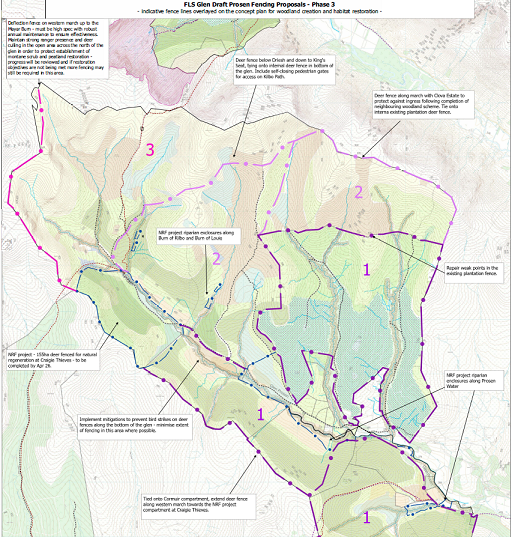
“We have developed a draft proposal for fencing in Glen Prosen that combines perimeter deer fences with internal compartment fencing, alongside rabbit netting and some stock fences with electric offset wires, to provide protection for woodland establishment and open habitat restoration, whilst keeping the amount of fencing on site to a minimum and utilising existing fence line where possible – see ‘Map 5. Glen Prosen Fencing Proposals.’
Deer culling and rabbit control will continue alongside fencing to keep deer off site and protect the fragile montane habitats at the head of Glen Prosen. In Glen Doll FLS will carry on with the present deer culling both in the plantation forest and at Corrie Fee NNR. We envisage that as the windblow harvesting progresses in Glen Doll, large compartment fences will also been needed to protect the new restock of native woodland that follows.”
The logic here is completely bankrupt and shows that FLS’ senior management is no longer capable of translating policy into practice. There is no point in having a policy presumption in favour of deer culling and against deer fencing if FLS then propose erecting boundary fences, compartment fences, riparian woodland fences and deflection fences. The option of employing a few stalkers full-time and shooting deer as they try to cross into Glen Prosen, as Wildland Ltd has been doing in Glen Tromie, is simply not considered. That would be far better use of public money.
NatureScot bears a high degree of responsibility for this failure, as is evident from the proposal to create riparian woodland in Glen Prosen which they are paying for through the Nature Restoration Fund. This is part of a wider project, supported by sporting estate landowners because they think it will improve their salmon fishing at public expense, to restore “riparian woodland” in the Angus Glens:
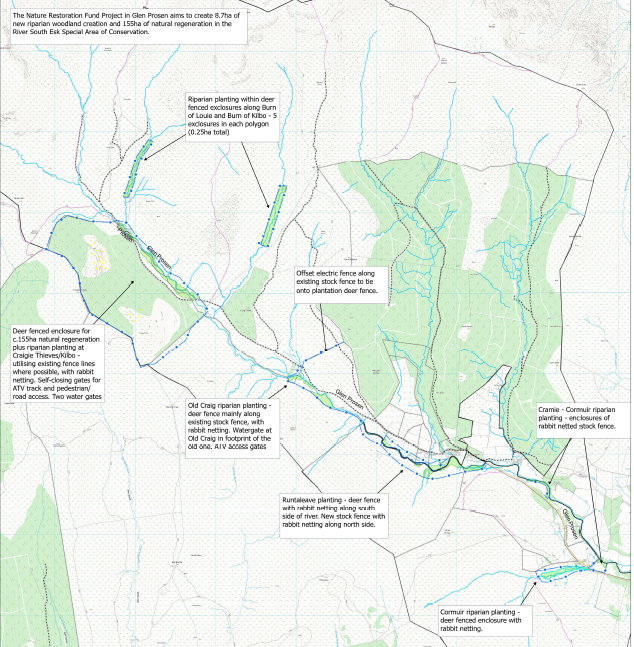
Deer fences galore! All of this would be completely unnecessary if NatureScot used their statutory powers to control deer numbers and reduced deer to 2 per square km, the level which FLS and many others now recognise is required to enable “nature” to restore itself.
The re-wilding alternative
The concept proposals, as currently developed, represent in my view a missed opportunity for re-wilding. Glen Prosen has been damaged ecologically because of the way human interventions have affected natural processes: muirburn, plantation forestry, artificially high numbers of red deer, road construction and wildlife persecution. Instead, however, of trying to “restore” this damage by yet more intervention, mainly in the form of planting native trees, why not just leave it to nature?
That is obviously something that would be very difficult for FLS, an organisation whose mission is to plant tree, to do. However, there are very few areas of moorland – open country – in Scotland where habitat development and ecological change is driven by natural processes. Most of the current re-wilding projects (Cairngorms Connect, Mar Lodge etc) are based around the regeneration of native woodland NOT native moorland. (The Cairngorms National Park Authority’s East Cairngorms Moorland Project (see here) is a bad joke and has completely failed to restore natural processes to moorland).
While some parts of moorland left to nature would, in time, develop into woodland, other parts might develop into bog, remain as moorland or form other types of habitat. Who knows? The point is that natural moorland, where heather is allowed to grow and die naturally (around 24 years) or expands after forest fires, would of itself be of great interest and is likely to support a far wider range of species than it does at present.
The lack of native woodland in Glen Prosen would make the process of native woodland development slow. Rather than seeing that as a problem, it should be seen as an opportunity to allow one or more generations of heather to regenerate naturally. Native trees would become established in places over time of course – seed brought in by the wind and animals – but the process of native woodland creation would evolve naturally rather than being a consequence of human intervention.
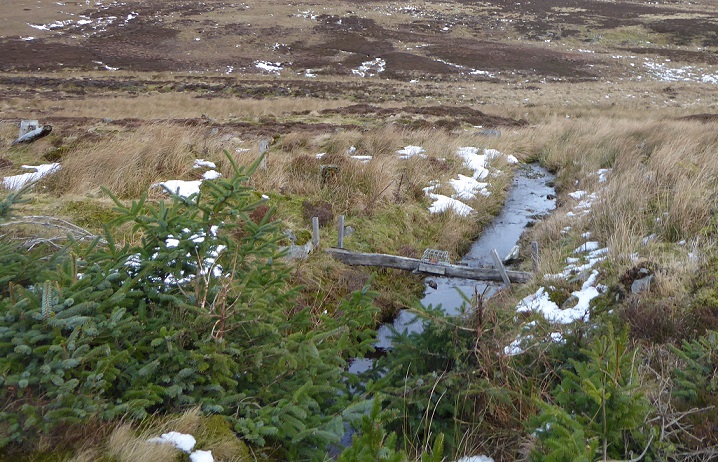
Non-native trees, however, would be another matter Given the plantations on site and just across the watershed to the south west, if grazing pressure was reduced sitka would likely to start spreading across the hillsides quite rapidly. There are already signs of that, a problem that is not mentioned by the FLS in their concept proposals.
What needs to happen?
Having bought the Glenprosen Estate to plant trees – wrongly in my view – there is little chance that either FLS or Scottish Ministers will drop their tree planting proposals entirely. They could, however, use the land to demonstrate a much more sustainable approach to native woodland creation and forest management, one which values other habitats and affords much greater respect to natural processes. Such an approach might involve:
No planting on peat, however thick;
- More limited planting on other soils to allow space for natural regeneration and to enable other habitats to develop/recover;
- All planting to be phased over a period of years until trees started to regenerate naturally. This would prevent the development of even-aged blocks of woodland, of limited value to wildlife, and do much to prevent the population explosions that accompany mass planting of trees;
- No mounding, to protect carbon in soils, no use of fertilisers/herbicides and no use of plastic tree shelters;
- Control of small herbivores that damage or kill trees would be left to predators;
- Significant and ongoing culls of deer to keep their density at 2 per square kilometre or less.
- No fencing;
- The creation of a native tree/plant zone, where all non-native species would be removed.
Lower down the glen, the adoption of a model of continuous cover forestry in FLS’ wrecked plantations might help make them more resilient to wind, pests and disease as well as better places for wildlife.
Such an approach would have considerable benefits compared to that set out in the concept proposal, including:
- The creation of permanent local forestry jobs (culling deer, tree planting – a small nursery? – weeding out non-native species etc);
- Enabling FLS to respond to natural regeneration on the ground over time and make it much more likely they could deliver the mantra of “the right tree in the right place”;
- Helping neighbouring landowners reduce deer numbers instead deflecting responsibility for culling deer onto them by putting up fencing;
- Demonstrating how public authorities can help deliver the statutory aims of our National Parks, including conservation, sustainable development and wise use of resources;
- Being far better value for money.
There are some good people working for FLS who have the skills and knowledge to make such an approach work, the problem is FLS’s management don’t appear to have involved them in the development of these concept proposals. Nor has that management paid much attention to the responses to the initial consultation as presented in FLS’ “feedback poster” (see here).
Unfortunately, the questions FLS are asking the public about the concept proposals that will drive the development of a land management plan for Glen Prosen are a joke (see here). Clearly, FLS don’t want the public or other stakeholders suggesting other options. Please consider taking 5 minutes to do so.

This is extraordinarily depressing and, in my view, comes about when authorities ignore what visitors want, concentrate on easily achievable targets and are in hock to pressure groups like Landowners and Developers . There are even more ludicrous decsions in the South. Your readers may be amazed to learn that the phrase Deer Cull includes Wallabies because they have a negative impact on natural regeneration. Indeed it could be that not culling the Wallabies on Inchconnachan may well be an offence. How do we stop the destruction. A Park is a Park.
Great take down of the FLS plans. All these elaborate maps (much of it pure fantasy), just to get some Sitka spruce in the ground!. Why is planting Sitka spruce so important to FLS? Are our citizens demanding it? Not likely. Much more cost-effective to cull deer and regenerate woodland using natural regeneration. If private corporations want industrial forests and Sitka for their Mills let them do it for themselves .
These proposals by FLS are crazy, a perfect example of the worst way to achieve value for money in the expenditure of public funds on climate change mitigation and biodiversity. The primary objective of this large tract of publicly owned land should be ecological restoration, starting from year 1. That will not be achieved by erecting great lengths of deer fencing and planting trees, all of which will put huge amounts of carbon into the atmosphere for decades to come. The focus for FLS should be on reducing deer numbers on their own land and neighbouring estates, preventing massive amounts of methane being emitted by these deer and allowing natural habitat to recover. If FLS are not prepared to do this the whole of their land holding in Glen Prosen should be transferred to NatureScot, the principle government agency responsible for deer management and ecological restoration. FLS should focus their efforts into acquiring land in the lowlands where tree planting to meet future timber requirements is an urgent requirement.
Just another example of what happens when some mirage of short term profit is encouraged by elected office. : the distortion of first principles of longterm land management through excessive and poorly monitored grant funding?
Precisely how much “carbon” is involved in the creation of steel fencing wires, in the mining of zinc to coat steel structures such as gates, instead of using wooden ones? How much carbon consumed in the milling of timber for fencing, and within industries to create and transport ‘toxic’ preservatives applied to fence posts and movement of all this ‘alien stuff’ up new tracks pecked and blasted through hills and glens ….just to rot – eventually. .
Today big headlines about the imminent imposition of financial penalties under the Scottish Government’s “circular economy” legislation? ( seen by -not a few people -as naive, urban, limited perspective, if not plain wishful daftness.) This story today appears alongside other BBC UK headlines about costs to landholders from rises in rural crime, fly tipping and other illegal activity across farm land. Part of that issue is said to be due to lack of Gov concern for funding effective preventative measures. But brand new barrier fences across wildland are still grant aided?
When did any idea of intelligent, far-sighted, joined up long term thought process within government agencies across Scotland, become so totally derailed? ( Circular economy ..dream on !!!)